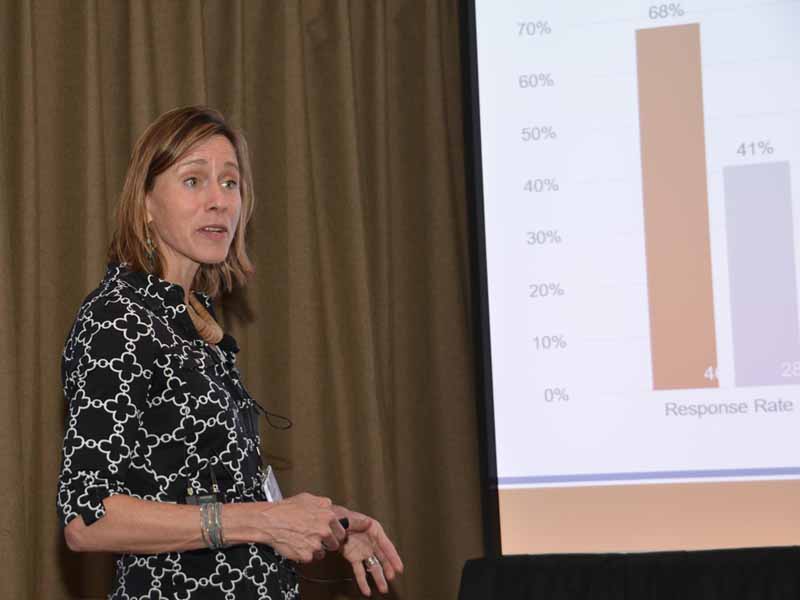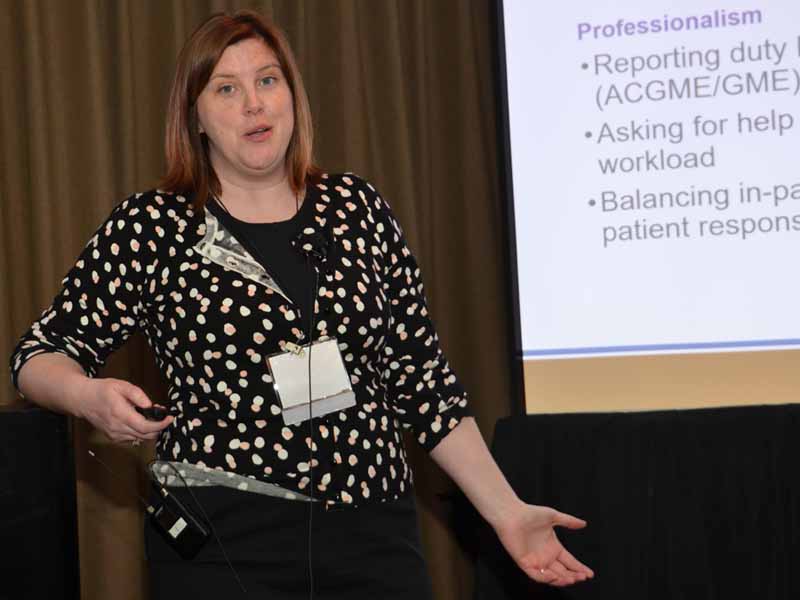Residency Program Solutions Conference
Taking a 'Measure What You Treasure' Approach to Burnout
April 16, 2019 05:21 pm Sheri Porter Kansas City, Mo. – Physician burnout has been a frequent headline topic the past few years, and discussions about how to provide relief to the medical community apply equally to physicians in practice and those in training.
So, it was no surprise that events planned for the AAFP's Residency Education Symposium, held here April 5-9, included a session during the Residency Program Solutions portion of the conference titled "Beyond Burnout: Building a Culture of Wellness and Professionalism in a Busy Urban Residency Program."
Presenters Katherine Gergen Barnett, M.D., program director of the Boston University Family Medicine Residency Program, and Kathryn Whitley, the residency's program coordinator, discussed burnout in general and what their program is doing specifically to promote wellness among residents.

Highlighting the Problem
Barnett began by answering her own thoughtful question: "Do we inherently come into medicine more burned out, less resilient, less optimistic and carefree? Actually, research shows the opposite."
She said a 2014 study published in Academic Medicine found that future physicians had excellent mental health before their medical education and training began.
Factors contributing to burnout include workload, "and we can't do a lot about that in residency," said Barnett. But perhaps other factors -- including practice efficiency, flexibility and control, integration of work and personal life, social support, and deriving meaning from one's work -- could become the focus of change.
Barnett briefly touched on both the professional and personal implications of burnout.
Physicians experiencing burnout deliver a decreased quality of patient care and are more prone to introducing medical errors. In turn, patient satisfaction decreases, said Barnett. "There's good data to support that the patient experience goes down when the person in front of them is feeling less engaged."
On an organizational level, administrators see decreased productivity and increased physician turnover. "I think this is true even for residents, and this is catastrophic to us as program directors or resident coordinators when a resident leaves, because we spend thousands of dollars to recruit and hire and train another physician," said Barnett.
Burnout also can have devastating personal effects on physicians, sometimes resulting in broken relationships, alcohol and substance abuse, depression, and even suicide, she added.
Story Highlights
Presenting Survey Results
Next, Barnett brought the problem home to Boston Medical Center. She presented results of two back-to-back burnout surveys of physicians, other clinicians and trainees, including residents and fellows, conducted in 2017 and 2018.
The surveys asked questions about burnout indicators, professional fulfillment and sleep-related impairment. Results showed that burnout among family medicine residents increased from 55% in 2017 to 64% in 2018. Sleep-related impairment rose from 74% to 80%.
"This was our heart-wrenching data … this was a wakeup call," said Barnett. "Our trainees were doing worse than attendings. What's the point of doing this kind of (survey) work if you're not going to do something about it?"
Those survey results became the driver for change. "We got that data back and said, 'What are we going to do, and how are we going to bring it to our residents?'"
Implementing Wellness Enhancements
Whitley took over the podium to discuss some implemented changes that should lead to more positive trends in the 2019 wellness survey that is to be distributed soon.
She noted the intensity of the residency schedule, in which 38 residents serve in five community health centers and shared how she squeezes their crazy schedules into 13 blocks of time. She wondered early on where she'd find time to put any residency wellness curriculum into an already packed schedule.
"The easy way to cover everyone is to fit it into our didactics because that's something already happening," said Whitley. And so, "every Wednesday from 1 to 5 p.m. is protected time."
The residency wellness program includes
- structured academic and wellness check-ins,
- individual support and counseling,
- working groups, and
- mentorship and quarterly social events organized specifically for residents who are underrepresented minorities.
Barnett interjected that the curriculum was created by a third-year resident in 2018. "So, this is all coming from the residents and the feedback they gave us," she said.

There's also a strong support system available to residents that includes an assistant professor in the Boston School of Medicine's Department of Family Medicine who also holds a master's degree in social work, a licensed independent clinical social worker who's available for short-term counseling and referrals, and a psychiatrist employed by the medical center.
"The psychiatrist is available to residents at all times, and he's very involved in wellness," said Whitley. He's also flexible on scheduling appointments, because he understands it's pretty difficult for a resident to be seen in ongoing counseling sessions when the schedules change every month.
New initiatives such as an eight-week grant-funded project that teaches mindfulness-based stress reduction are in the works, as well as something innovative created specifically for interns.
Barnett said administrators were hearing from interns that the intern year was so full and overwhelming that they forgot why they went there in the first place. As a result, the program created a few special sessions and labeled them "intern scholarly time for the pursuit of scholarly activities," said Barnett.
"Residents can spend that time talking about how to have one-on-one meetings with the faculty or how get out of the hospital and into the community," she said. The end goal is to give our interns time to think about "how to continue building their dream of who they want to be when they graduate," she added.
Sharing Best Practices
The presenters left time for attendees to share their programs' best practices, and several were eager to discuss their successes.
For instance, one residency program allows residents to request five wellness days a year -- no questions asked. "They just say they need a wellness day and we'll work with their schedule to do that," said the administrator.
At residents' request, "we took wellness out of the classroom," said another. Each quarter the program dedicates half a day to a group activity, such as a two-mile walk ending with breakfast at a coffee shop.
The same program surveys residents every block or two to track their wellness and burnout. "If we see someone starting to trend in a way that is concerning, we all huddle around that person to find out what's going on and how we can help," said the program director.
Another residency encourages residents to chart their level of wellness or happiness on a plot graph. "That's real telling right there and can start a conversation and catch someone early on who might be struggling," said the administrator.
One residency program reserved a wintery Wednesday afternoon in December 2018 for an activity called "crafting away the winter blues" that had residents and faculty members elbow to elbow baking cookies, painting gourds, tying fleece blankets and enjoying one another's company.
And on the third Wednesday of the month, another program plans a wellness activity that could involve a garden tour, a massage day or manicures for all provided by students at local trade schools eager for some experience.
Lastly, after some residents shared that they'd never felt as happy as when they were lobbying for funding for teaching health centers, a residency program in the Washington, D.C., area created a "come along with me" initiative that encourages residents to get personally involved in creating systemic change at the federal level.
Barnett admitted that preserving wellness and beating back burnout is hard work. "We need to measure what we treasure, and we're not going to stop doing our burnout survey when the results are painful," she said.
"This is not easy, and it's a long journey; there is no magic bullet," she added.
Related AAFP News Coverage
Massachusetts Groups Call Physician Burnout Public Health Crisis
AAFP's Well-being Resources Help FPs Answer Challenge
(2/8/2019)
Q&A With Clif Knight, M.D.
Physician Well-being: Building on a Strong Foundation
(1/2/2019)
More From AAFP
Physician Health First